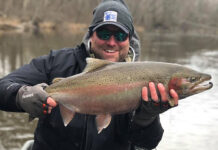Shortly after my wife and I moved to the ridge back in the summer of 1985, we began exploring the surrounding woods. On one of our first outings, we took separate paths. When we met back at the house, Linda was bursting with excitement.
“I got a quick look at an animal I didn’t recognize,” she said. “It looked like a deer, but it was ghostly — all white and the size of a goat.”
It turned out that Linda had seen a snow white fawn, one of twin white fawns tended by a normally colored doe. Over the course of the rest of the summer and fall, we saw them often. Sometimes they even came into the yard.
The first sighting
It was the first time we had seen white deer, and we felt privileged to have them so near. We understood why Native Americans associated white deer with goodness and why people often feel protective of white deer that live near their homes.
We watched as they grew and matured that first year. Even 200 yards in the woods, they were easy to spot against the gray autumn background. But when snow fell, the white fawns disappeared into the snowscape.
Though unusual, neither of these white deer was a true albino. Each had a black nose, dark eyes, a brown forehead, and a few dark patches on the body. The locals called them piebalds. True albinos lack all dark pigment (melanin) and have pink eyes.
By the following September, after each had turned one year old, it was clear that one was a female and one was a male. The buck grew a pair of spike antlers; he disappeared during the hunting season. The local buzz among unhappy neighbors was that out-of-state hunters had killed the white buck.
Doe lives long life
The doe, on the other hand, lived a long productive life; she gave birth to normally colored single or twin fawns each spring for seven years. Apparently no local bucks carried the genes to make white deer.
The white doe died during the blizzard of March, 1993. We feared for her the previous fall when she began to lose hair on her back. By mid-winter, she had big patches of bare pink skin. I suspect when the blizzard struck she could simply no longer maintain her normal body temperature.
In the ensuing 25 years, we have not seen another white deer, though we have seen a few with white patches. So the “white” genes are still out there in the population. Perhaps some day a buck and doe carrying those genes will again mate and give us a ghost.
Memory trigger
What triggered these memories was a story a reader sent me about a herd of white deer near Boulder Junction, Wis. Video of these woodland apparitions can be seen in a clip from Wisconsin public television by Googling “Wisconsin white deer.”
Photographer Jeff Richter’s book, White Deer: Ghosts of the Forest (2007, www.naturespressbooks.com, $19.95), tells the story of this amazing herd.
Though not rare, white deer are unusual, and most people are lucky to see one in their lifetime. And when they do, it always seems special. I often hear about such observations because people enjoy telling how they saw their first white deer. That, in fact, is the genesis of Richter’s book.
Nature photographer
Richter, a nature photographer, saw his first white deer in a stand of waist-high ferns in northern Wisconsin.
“What was at first glance unrecognizable,” he writes in the introduction, “turned instantly to an unforgettable encounter with my first white deer when it raised its head and looked directly at me.” The photograph on page 15 recreates that moment for the reader, and we realize how an obsession was born.
Though primarily a picture book, “White Deer” includes supplemental information by nature writer John Bates that answers many of the questions readers have about these amazing animals.
But it is Richter’s photos that make the book. Gleaned from thousands of images taken over a period of 10 years, they tell the story of a place, where for some reason, white deer are more than fleeting ghosts. They have become a part of the fabric of Boulder Junction, Wis.












